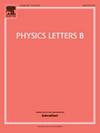DSR中的两体狄拉克方程:费米子-反费米子对的结果
IF 4.3
2区 物理与天体物理
Q1 ASTRONOMY & ASTROPHYSICS
引用次数: 0
摘要
本研究受Amelino-Camelia的双重狭义相对论(DSR)启发,在2+1维时空中研究了一个修正的二体狄拉克方程。我们首先推导出一个协变二体狄拉克方程,在没有DSR修改的情况下,它可以简化为贝塞尔型波动方程。结合所选DSR模型的修正修正了该波动方程,得到了与低能区已建立结果一致的解。我们证明,在较大的相对距离上,DSR变化的影响变得特别明显。对于耦合费米子-反费米子对,我们导出了修正的结合能解。通过考虑一阶普朗克尺度修正,我们发现精细结构常数α表现为与能量相关的运行参数,由αeff(E)/α≈1−E4Ep给出,其中Ep为普朗克能量。利用DSR修正的一阶近似计算结合能,并将结果应用于类正电子系统。我们的模型显示,DSR的改变会引起结合能的位移。据我们所知,dsr修正的二体方程之前还没有被研究过。该模型是同类模型中的第一个,为该领域的进一步研究开辟了新的途径。本文章由计算机程序翻译,如有差异,请以英文原文为准。
Two-body Dirac equation in DSR: Results for fermion-antifermion pairs
This study investigates a modified two-body Dirac equation in -dimensional spacetime, inspired by Amelino-Camelia's doubly special relativity (DSR). We begin by deriving a covariant two-body Dirac equation that, in the absence of DSR modifications, reduces to a Bessel-type wave equation. Incorporating corrections from the chosen DSR model modifies this wave equation, yielding solutions consistent with established results in the low-energy regime. We demonstrate that the effects of DSR modifications become particularly pronounced at large relative distances. For a coupled fermion-antifermion pair, we derive the modified binding energy solutions. By accounting for first-order Planck-scale corrections, we show that the fine-structure constant α behaves as an energy-dependent running parameter, given by , where is the Planck energy. Binding energy levels are computed using a first-order approximation of the DSR modifications, and the results are applied to positronium-like systems. Our model reveals that DSR modifications induce shifts in the binding energy levels. To the best of our knowledge, DSR-modified two-body equations have not been previously studied. This model is the first of its kind, opening new avenues for further research in this area.
求助全文
通过发布文献求助,成功后即可免费获取论文全文。
去求助
来源期刊

Physics Letters B
物理-物理:综合
CiteScore
9.10
自引率
6.80%
发文量
647
审稿时长
3 months
期刊介绍:
Physics Letters B ensures the rapid publication of important new results in particle physics, nuclear physics and cosmology. Specialized editors are responsible for contributions in experimental nuclear physics, theoretical nuclear physics, experimental high-energy physics, theoretical high-energy physics, and astrophysics.
 求助内容:
求助内容: 应助结果提醒方式:
应助结果提醒方式:


